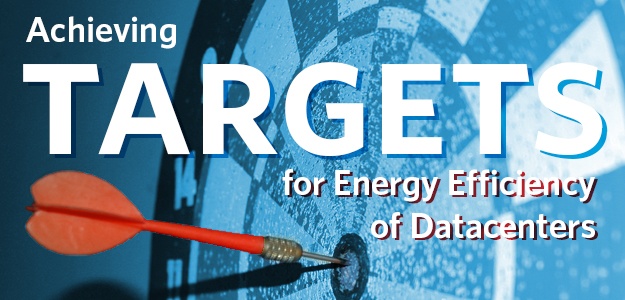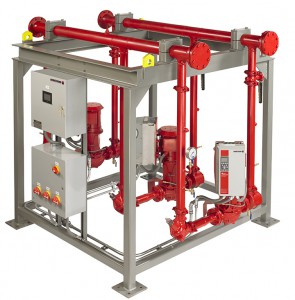By Dominic Cutts
Director – System Solutions at Armstrong Fluid Technology
The HVAC industry is awash with acronyms but, if you are designing, installing or maintaining systems for datacenters, then the acronym that really matters is PUE. The PUE™ (Power usage effectiveness) metric provides a universal benchmark against which the environmental performance of every datacenter can be measured. It has been developed by The Green Grid Association (a non-profit, open industry consortium of end users, policy makers, technology providers, facility architects, and utility companies) and carries significant weight within the datacenter community. Whilst the guidelines issued by Green Grid and others (such as the EU Code of Conduct on Datacenters' Energy Efficiency) are currently voluntary rather than mandatory, these initiatives for accreditation and benchmarking of environmental performance provide powerful commercial advantages for those datacenter operators able to differentiate themselves through investment in energy efficiency.
“as much as 45% of the energy costs
of a datacenter can relate to HVAC”
IT equipment, of course, is a huge consumer of electricity in its own right and emerging technologies, such as virtualization and blade servers, are believed to be pushing up energy consumption by between 5% and 10% per year. Increasing processing capacity also escalates demand for cooling, and as much as 45% of the energy costs of a datacenter can relate to HVAC. Unsurprisingly, datacenters are thought to be responsible for around 3% of the UK’s total electrical energy use.
The PUE metric is so significant for the HVAC industry because it provides, at a glance, a picture of the efficiency of the energy consumed both for processing and for cooling. A PUE of 1.5, for example, means that for every unit of power used on core IT equipment, an additional 0.5 units is spent on the supporting infrastructure.[1]
The challenges of reducing the IT equipment’s demand for power are considerable (as they impact on processing capability), so the battle to improve PUE focuses on the supporting cooling systems. This fundamentally changes the relationship between the datacenter operator and its HVAC supplier. The demands are intensified (as the HVAC supplier has a direct impact on its customer’s competitiveness) and sustainability performance is continually scrutinized and transparently reported. In addition, the critical nature of these cooling applications means that upgrade cycles (and payback periods) are typically shorter than those of traditional commercial premises.
So what factors need particularly close attention when working with customers of this type? Firstly, of course, energy efficiency is paramount, necessitating careful consideration of control methodology. Secondly, systems need to be designed for incremental expansion rather than installing full capacity from the outset. Thirdly, critical cooling requires several safeguards around reliability and fail-safe modes. Fourthly, this is a fast-moving and entrepreneurial business sector requiring delivery schedules far shorter than those of traditional construction projects.
Energy efficiency
Capacity based control systems are inadequate to meet the exacting energy efficiency targets of datacenter cooling. Instead, of designing your chilled water system based on independent control loops with PID feedback control, look for demand based control methodologies (for example Hartman LOOP™ digital relational control) capable of treating the entire system ‘holistically’, rather than as individual sub-systems. This provides a number of benefits, such as sequencing key energy consuming components, such as Armstrong Design Envelope pumps, to operate along their natural curve for all load conditions.
Incremental expansion
New datacenters are established with the intention of expanding to full capacity over time, so best practice is to specify HVAC solutions featuring modular design, capable of ‘bolting-on’ additional cooling in line with expansion of IT processing capacity. This assists the datacenter operator’s profitability by preventing the need to front-load capital investment for the facility, and avoids the significant energy wastage of over-sized plant. Armstrong iFMS modular packaged pump solutions are ideal, as they are pre-designed, off-site manufactured pump packages that are fully-configurable to suit the application. Avoiding bespoke design, the iFMS also meets the demand for predictability and reproducibility of environmental performance which is so important in critical cooling applications with transparent reporting.
Reliability
Off-site manufacture has proved extremely popular for these applications, as assembling and integrating a complete chilled water plant room, or pump package, in the controlled environment of a factory provides the best possible guarantee of system integrity. Testing can be carried out in the factory under controlled conditions prior to delivery, and the best solutions incorporate fail-safe features. Armstrong’s self-contained IPP-CHW fully-integrated chilled water plant package, for example, is a popular solution.
Delivery times
Off-site manufacture also satisfies the demanding timescales required by datacenter operators, both when establishing new facilities, and when upgrading systems at existing sites. For example, specifying Armstrong IPS (Integrated Pumping Systems) removes the assembly of the cooling infrastructure from the project’s critical path, reducing time to market.
In conclusion, critical cooling applications of this type provide challenges and opportunities in equal measure for the HVAC industry. The technical solutions already exist to meet these challenges, however, and as datacenter operators do battle over PUE, suppliers of chilled water systems will become increasingly important allies.
[1] AMA Research, ‘UK Datacenter Construction Market Report’, February 2014






